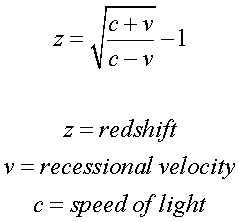

If the absorption or emission lines they see in the star's spectra are shifted, they know the object is moving either towards us or away from us.įor far away objects such as quasars, some of which are too faint to be observed by spectroscopy, astronomers measure photometric redshifts.

Astronomers can look at the spectra created by different elements and compare these with the spectra of stars. This is known as a spectrum (plural: spectra). When a beam of white light strikes a triangular prism it is separated into its various components (ROYGBIV). The most accurate way to measure redshift is by using spectroscopy. The video below demonstrates the concepts of the Doppler Effect and redshift. In the case of light waves, this is called blueshift. As an object moves towards us, sound and light waves are bunched up, so the pitch of the sound is higher, and light waves are moved towards the blue end of the electromagnetic spectrum, where light has a shorter wavelength. In the case of light waves, this is called redshift. As an object moves away from us, the sound or light waves emitted by the object are stretched out, which makes them have a lower pitch and moves them towards the red end of the electromagnetic spectrum, where light has a longer wavelength.ĭoppler effect example: Sound waves from a police car siren. Redshift is an example of the Doppler Effect. For example, if an object is redder than we expected we can conclude that it is moving away from us, and if it is bluer we can tell that it is moving towards us. You're welcome to use any tool that can arrange text on a page, but please submit something Canvas can open (Microsoft Word, Powerpoint, or a pdf).Astronomers can learn about the motion of cosmic objects by looking at the way their color changes over time or how it differs from what we expected to see. Is this galaxy appear to be moving toward or away from us? What is the average redshift for the two stars you found, and for the two galaxies? How do the stellar redshifts compare to the galactic redshifts?įor the galaxy with the greatest redshift, are its spectral lines shifted to longer or shorter wavelengths?įor this galaxy, calculate the velocity that corresponds to it's redshift. The thumbnail images of the lowest and highest redshift galaxies from your sample, labelled with their redshift.Ī short paragraph answering the following questions: The thumbnail images of the lowest and highest redshift stars from your sample, labelled with their redshift and velocity ( use the redshift equation, v = cz, as explained above ). If the table is blank, I'm sorry, but you should go back and find a new place by clicking the "Use Constellations Notebook" button in step 2. Copy thumbnail images and rounded redshifts for the lowest and highest redshift galaxies into your document. Now change the class to galaxy (type GALAXY in the class box) without changing the other columns. Copy the thumbnail images for these two stars to your document and label them with their redshift- rounded to a few significant figures-and velocity ( use the redshift equation, v = cz, as explained above ).


 0 kommentar(er)
0 kommentar(er)
